
Operating under the cover of darkness, slugs and snails can do massive damage to garden plants in a very short period of time.
Each evening, they leave their cool and dark hiding spots beneath rocks and fallen leaves and descend upon a wide range of garden cultivars.
Any succulent plant tissue is fair game, including fruits, vegetables, flowers, and herbs. Young seedlings are especially vulnerable and are often consumed in entirety.
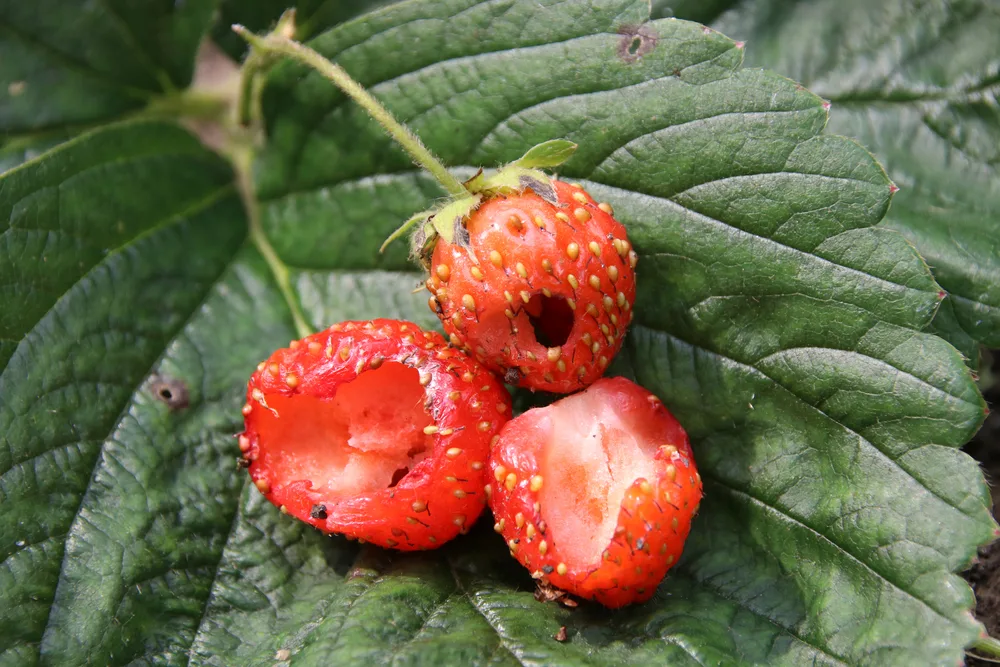
About Slugs and Snails…
Snails and slugs are not insects but terrestrial gastropod mollusks, from the same phylum as clams and squids.
Both have similar physical structure, with soft, unsegmented bodies covered in slimy mucus that helps prevent them from drying out.
The most noticeable difference between them is snails have a hard shell with a logarithmic spiral while slugs are shell-less. The lack of a shell makes slugs more prone to desiccation while snails have better protection against drought and heat.
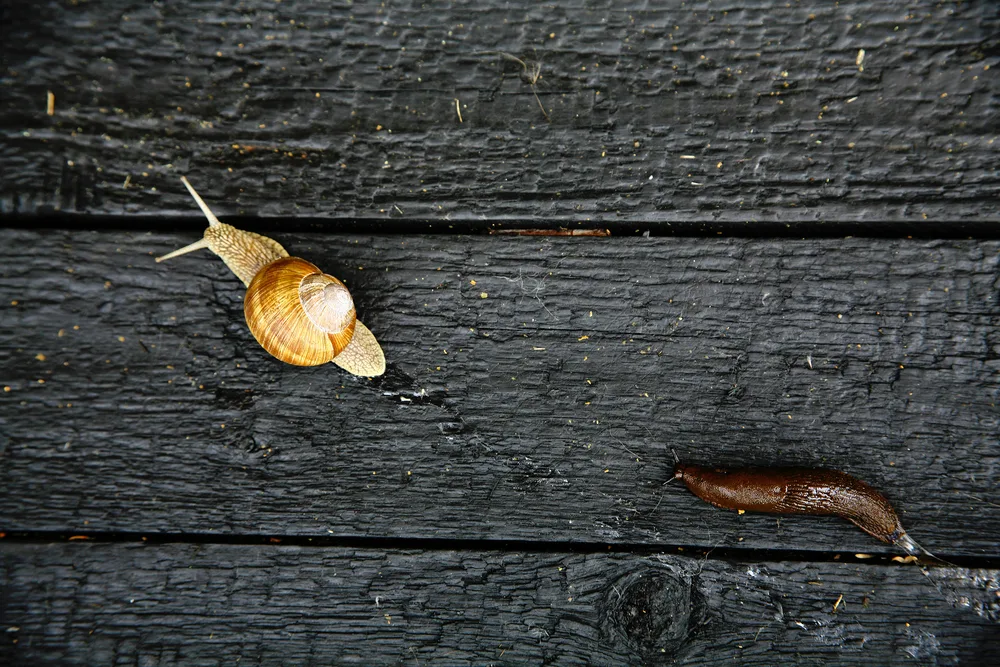
As gastropods, they have a “stomach foot” that allows them to move at very slow speeds – only one millimeter per second. Movement is accomplished through cascading muscular contractions that advance the foot slightly forward. However slow, some slugs can travel up to 40 feet per night in search of food.
Snails and slugs are found all over the world but are more common in temperate, humid environments. They require moisture to survive and will reproduce quickly during a particularly rainy season.
In cooler gardens of the north, slugs and snails hide away in hibernation over the winter and re-emerge in spring.
How to Identify You Have a Slug or Snail Problem
Snails and slugs usually only feed at night but can sometimes be spotted during the daytime on overcast, foggy, and rainy days.
You may not catch them in the act of munching down on your plants but they do leave behind a telltale trail of destruction. Because they eat in a back and forth, file-like motion, larger leaves will show irregularly shaped holes with smooth edges.
As they lumber around the garden, they will deposit slimy mucus wherever they go. Look for streaks and puddles of ooze on the surface of leaves and on top of the soil around the base of plants.
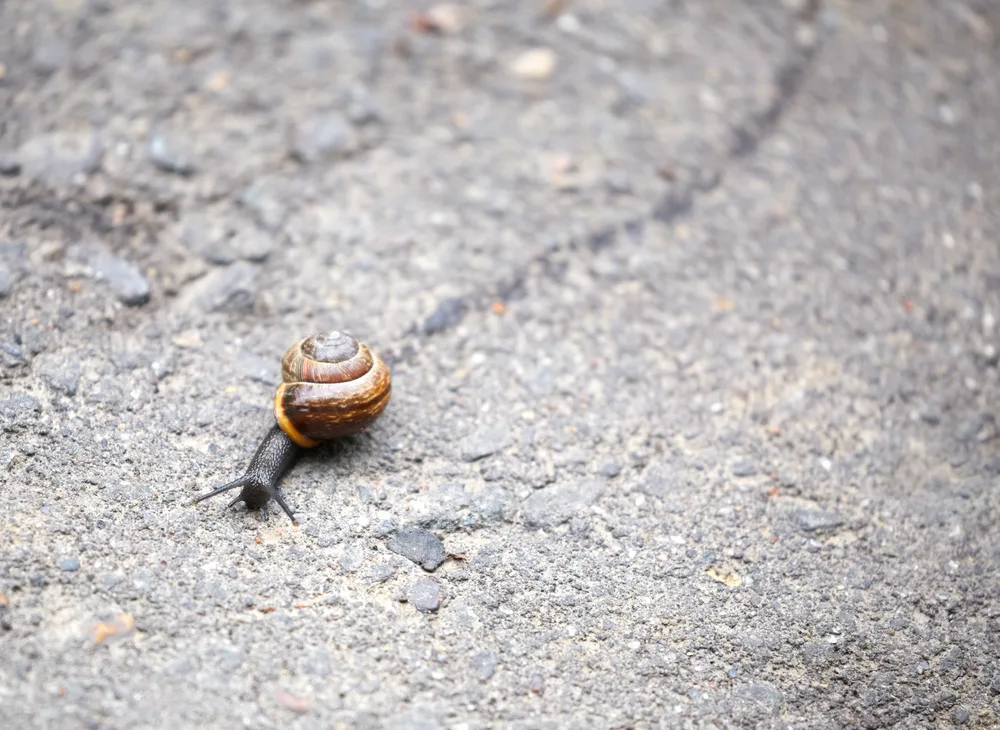
Although they are generalists that will feed on living plants and decaying organic matter, slugs and snails prefer the soft and tender growth of freshly sprouted seedlings. New growth on established plants is also a favorite food.
Be more watchful over leafy greens like lettuce and tender herbs like basil. Hostas and other foliage plants are not immune, nor are petunias, daisies, lilies, and other flowering plants.
In addition to leaves and stems, they will also feed on strawberries, tomatoes, beans, carrots, peas, and apples.
8 Ways to Stop Slugs and Snails Naturally
Each slug and snail roving around your crops can eat up to 40% of their weight every day. Put a stop to their nightly raids with these tactics:
1. Remove Hiding Spots
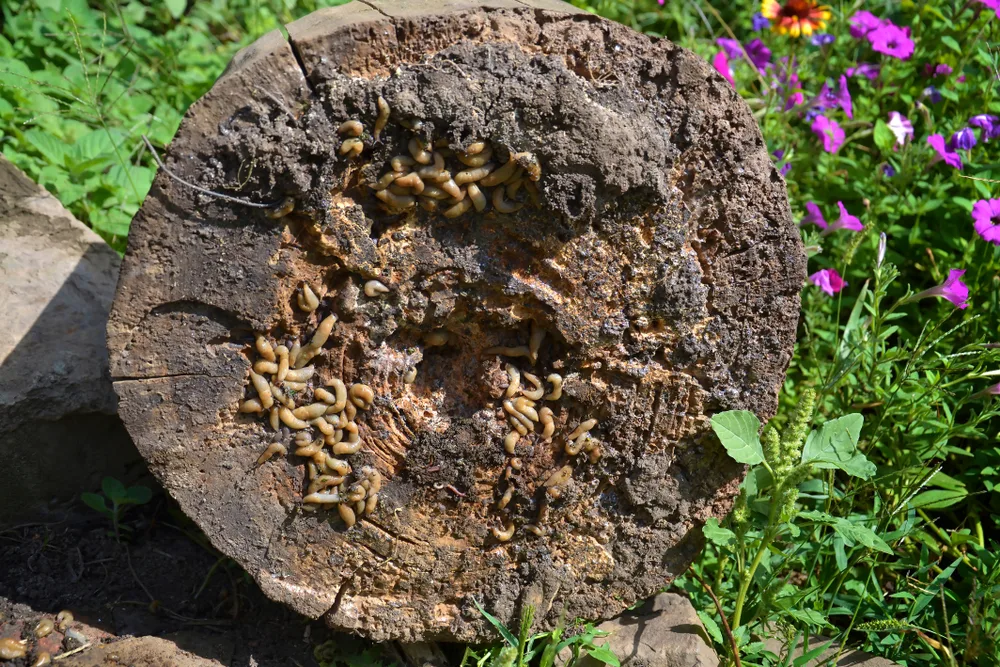
After their nocturnal feast, slugs and snails will retreat to dark and cool hiding spots close to flower and vegetable beds.
Make your garden as unwelcoming as possible by removing any objects and debris that are in direct contact with the soil.
This includes raking up leaves, moving rocks and stones, and storing piles of bricks or wood logs or lumber elsewhere.
Wood chip mulch provides safe harbor for snails and slugs too so avoid using it in your vegetable patch whenever possible. Straw and pine needle mulch are good alternatives.
Garden furniture and décor may need to be re-evaluated as well. Flower pots and container gardens should be kept elevated off the ground. Relocate statues and sculptures away from your food crops.
2. Encourage Their Natural Predators
Slugs and snails have many natural predators in the wild. Let them do the work for you while strengthening the food web and fostering balance in the garden.
Birds are effective slug and snail hunters, sussing them out of their hiding places throughout the day. Blackbirds, jackdaws, thrushes, doves, starlings, owls, and vultures are among the many species of bird that prey upon slugs and snails. Add a bird bath and grow plants birds love to attract them to your garden.
If you keep ducks, turkeys, or chickens, allow them to range wherever slugs are a problem.
Some insects – such as ground beetles, ants, fireflies, and marsh flies – will aid in keeping snail and slug numbers in check. Grow more native plants to encourage a healthy insect population in your backyard and build a bug hotel to ensure they stick around a while.
Reptiles and amphibians love to snack on snails and slugs as well. Frogs, toads, lizards, and snakes are well regarded slug eaters. Adding a pond or other marshy water feature is a way to entice these creatures into your yard.
3. Keep the Topsoil Dry
While keeping your garden beds well watered is generally a good thing for your plants, having an always moist plot is very attractive to resident snails and slugs.
Since they operate in slime, crawling over dry land means they lose a lot of mucus along the way. The loss of mucus dries out their bodies and slows them down.
While there’s not much you can do when it rains, how you water your garden does have a big impact on slug populations.
Whenever possible, only water your gardens in the morning. This allows the upper layers of soil to dry out a bit before nightfall.
Instead of watering the entire plot, water each plant individually and only around the base of the stem.
In lieu of sprinklers that will saturate large areas, invest in a drip irrigation system like this one to target each plant. Or use water rings to keep plants watered without soaking the whole area.
4. Hand-Picking
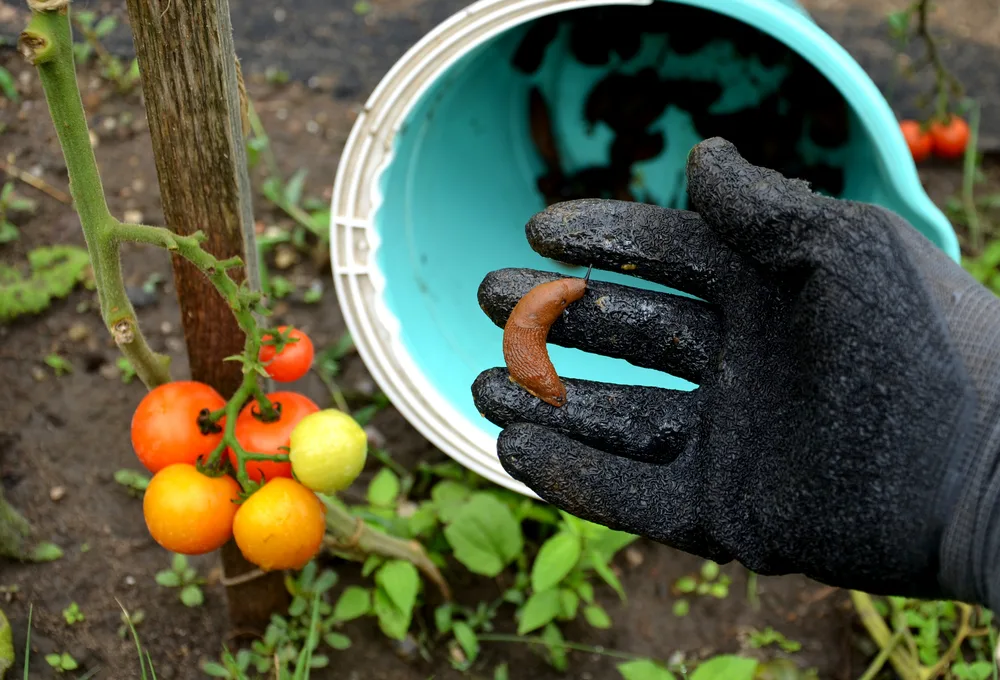

Are you missing out?
Join the 46,285 other gardeners who get the best of Rural Sprout delivered right to their inbox every Wednesday and Sunday!
Although quite rudimentary, hand-picking slugs and snails to remove them from their food source will produce immediate results.
Venture into your garden at night, about two hours after sunset. Use a flashlight to check around plants, looking at the tops and bottoms of leaves, at the base of each plant, and along the soil between rows. Once snails and slugs are located, use a spoon to dislodge them from the surface.
Be thorough when searching and remove slugs and snails daily for the first week or so. Once you’ve noticed their populations decline, weekly hand-picking sessions will keep their numbers in check.
Place found snails and slugs in a bucket of soapy water or rubbing alcohol to quickly kill them.
Alternatively, you can toss living slugs and snails in your compost heap.
Providing a dark and moist space with plenty of food for them to eat and no need to travel will encourage them to stay put and help keep them away from your garden. It’s beneficial for the compost as well, since they help in processing all that organic matter just a little bit faster.
5. Snail and Slug Traps
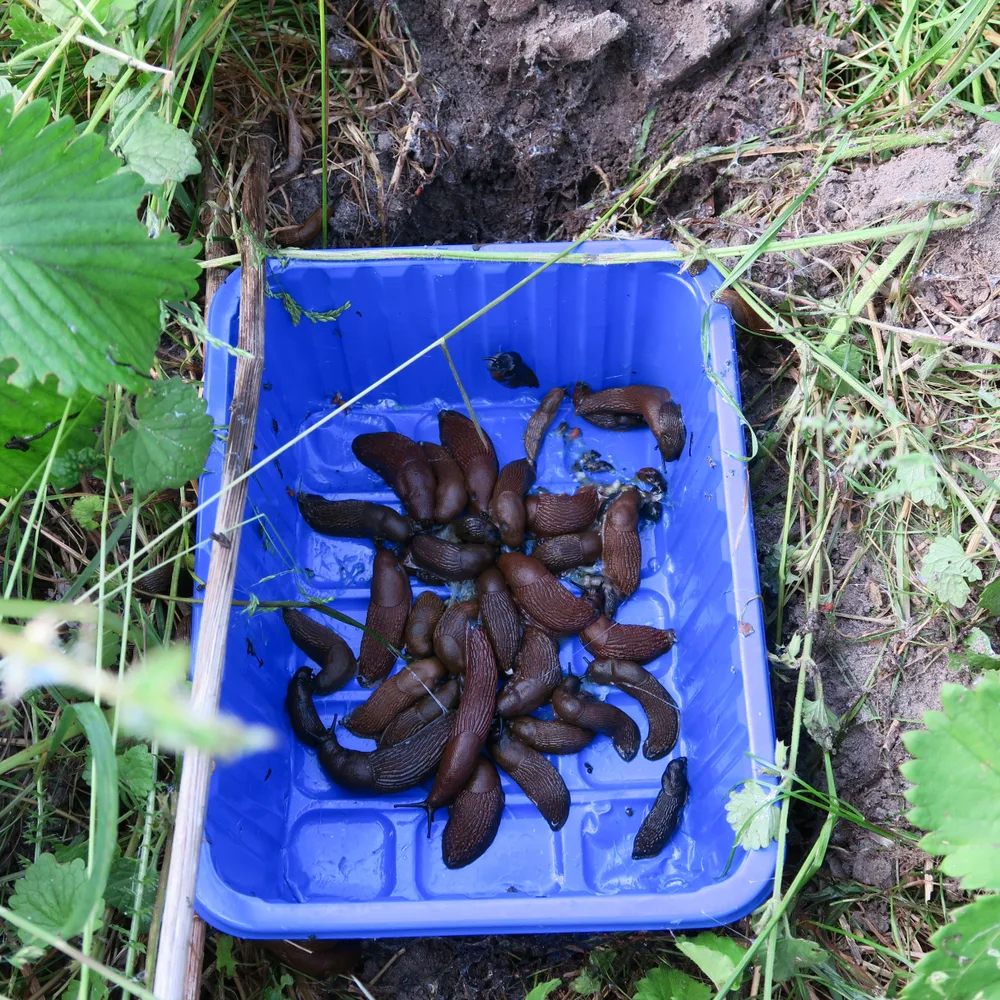
Luring slugs and snails to specific areas of your garden makes it much easier to collect them.
Create an ideal daytime sheltering spot in a cool, moist, and dark place by setting down pieces of cardboard or wooden boards directly on freshly watered soil. Flip these over each day and remove any snails and slugs that have congregated along the underside.
You can also dig holes around the garden, each about 6 inches deep and 4 inches wide. Cover the each hole with cardboard. Or simply nestle a few flower pots, upside down, into the soil next to the garden.
You can bait these traps by tossing in some grapefruit or melon rinds.
Don’t forget to check these live traps daily! Not removing the accumulated slugs and snails each day runs the risk of them devouring your plants in even greater numbers.
Another effective trick is to fill shallow containers with one inch of stale beer. Nestle them into the soil so that the top edge of the container lines up with surface of the soil. Place them 10 feet apart throughout the garden.
Beer is very appealing to snails and slugs, drawing them into the liquid where they will drown. Put them out in the early evening. Empty the containers every few days and top up the beer regularly.